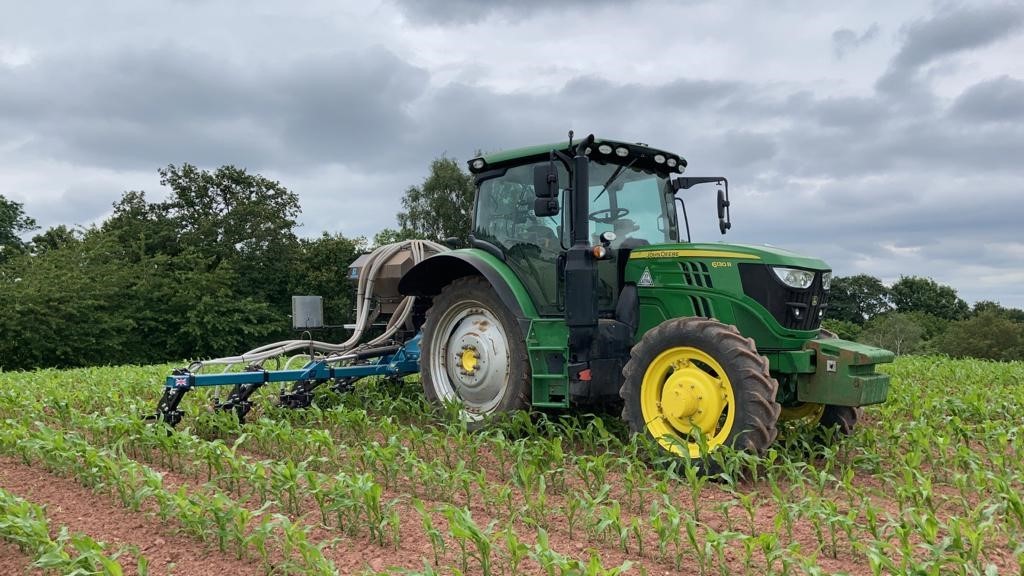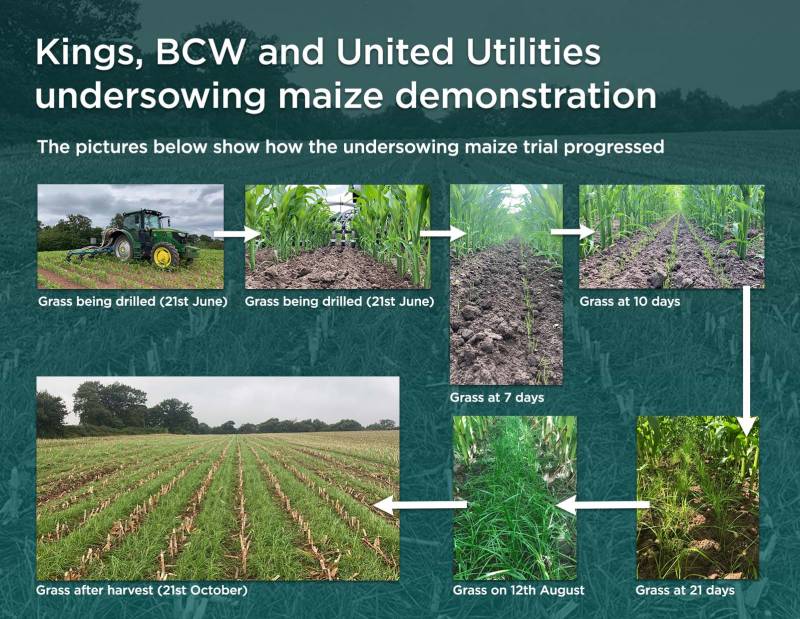Undersowing maize – A demonstration event
Maize is an important crop on many farms across the country, from east to west and increasingly north to south. For those growing it, however, there are some issues which can arise from bare maize stubbles left over winter and it's important to mitigate them. If left, the land can become vulnerable to surface water runoff, soil erosion and nitrate leaching.
Where exposed land could be a risk, the main solutions are either drilling a post-maize cover crop or undersowing maize with grass. The former can be an excellent option in the right conditions and at the correct time of year – usually before mid-October. However, there is always the risk of harvest being delayed, or that soils are too wet for the cover crop to be established.
This brings us to the other option – undersowing maize. It can have several economic and environmental benefits, including:
- Enhancing soil structure and organic matter
- Reducing soil erosion
- Retaining soil nutrients
- Providing winter/spring grazing opportunities.
A method that meets legislation requirements
The responsibility to mitigate any damaging effects to soil and water or loss of nutrients is an important part of cross compliance regulation from the Rural Payments Agency. These requirements will be in place until at least 2024 and state "You must take all reasonable steps to put suitable practical measures in place to prevent excessive soil and bankside erosion."
If anything, commitments to such measures are only like to increase. In Holland for example, it is now legislation that all maize crops should be followed by the planting of a green cover crop. For UK growers, there is increasing pressure from water companies and the anaerobic digestion supply chain too; both of which are encouraging farmers to grow cover crops after maize or undersow green cover into the crop.
For those of you considering the undersowing approach, we know you will likely have several questions. In order that we can share relevant findings and advice to support growers exploring the method, we've worked with BCW Agriculture, United Utilities and Darley Hall Farm in Cheshire to host demonstration trials, with the work and results monitored regularly to determine the best course of action.
Undersowing maize: a farm demonstration
The objective of our work with BCW, United Utilities and Darley Hall Farm is to assess how successfully (or otherwise) establishment of undersown grass can be achieved.
Darley Hall Farm is based just outside the village of Cotebrook in Cheshire and is farmed by Simon and Ed Atkin. As growers of maize, Simon and Ed were keen to reduce the risk of erosion and runoff and wanted to see if an economic crop of grass could be established into the growing crop.
Similarly, water services company, United Utilities is also undertaking projects to look at the impact of undersown grass in nitrogen leaching.
By linking together with BCW agronomist, Nick Jones, the demonstration work was carried out on a 13 hectare block of land which was growing continuous maize.
The maize establishment records are outlined below:
| Activity | Date | Comments |
| Nutrition application – this was based on SOYL Nutrient analysis. | 29/04/21 | FYM ploughed in - 18 tons/ha MOP incorporated into seed bed - 250kgs/ha Maize trace starter fertiliser with seed at drilling - 150kgs/ha, 28.5N, 55.5P, OK, 18S + boron |
| Maize drilled | 02/05/21 | Seed rate 42,000 seeds/acre Variety - Calvini |
| Herbicide | 03/05/21 | Pre-em applied |
| Herbicide | | Post-emergence spray was used to take out broadleaved weeds but with enough interval not impact on the grass establishment. |
The full results of the work will be known in the spring but there are already a number of learnings to share.
Following on from the above establishment schedule, undersowing of the grass took place on the 21st June with Kings Sprinter Mix drilled at 17.2kg/ha. This mix is a 50/50 split of Westwolds and Italian rye. These grasses work well in this situation as they are they fast to establish and will not head under the maize , although will grow away quickly after harvest. Sowing took place with the maize at 6-leaf stage; at this point the maize is well enough established.
The drill used was a Landwrx Inter Seeder, which is specifically designed for this task. Using a drill is far more reliable than simply broadcasting the seed because it provides much better germination.
The diagram below demonstrates how the grass established:
The learnings so far
Given the findings of the work to date, both the farm team and United Utilities are very pleased with the impact seen from undersowing grass into the maize crop. The cover has certainly helped with soil structure; something which was confirmed by the maize harvest contractor who commented how well their trailer travelled the ground.
Another important note is that there has been no yield loss across the plot, with the maize crop returning 47.5 tonnes/hectare. In addition, with the sloping ground on this site, the cover from the grass should help prevent or at least minimise the risk from soil erosion and run off through the winter months.
At this time of year, many of you will be considering which maize variety to grow in 2022 but it's also a good time to think about overall ground management and what measures you can put in place to support your plots, soil structure and nutrients. Given the positive results recorded so far, you may want to begin thinking about your options for undersowing with grass – something we're very happy to offer support and advice with.
If you'd like to know more about undersowing maize or our work with United Utilities and other water companies, please speak to your Kings advisor or contact the team.
As a subscriber, you’ll receive email alerts each time a new blog is published so you can always stay updated with the latest advice and insights from our experts





Comments